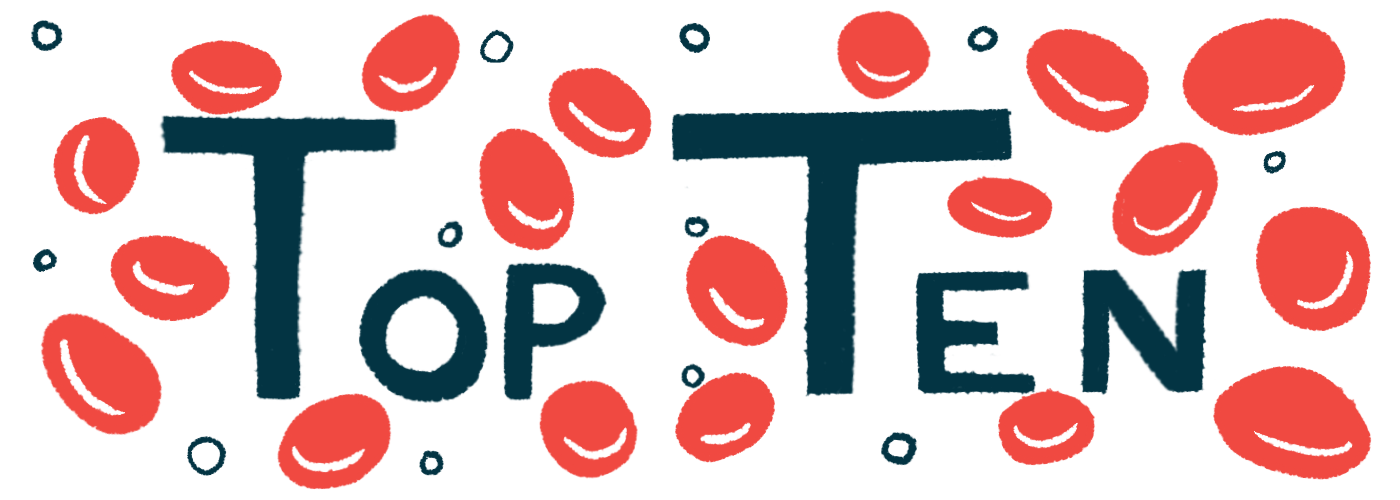Top 10 Sickle Cell Disease Stories of 2022
A compilation of the most-read stories of the year from Sickle Cell Disease News
Written by |

We at Sickle Cell Anemia News have brought you coverage of the latest developments in research and advances in treatment related to sickle cell disease (SCD) in 2022.
We look forward to continuing being a resource for the sickle cell community in 2023. Here we’ve compiled a list of the 10 most-read articles published on our site in 2022, with a brief description of each.
No. 10 — “Trial of Cell Therapy to Raise HbF Levels Showing Potential, But Sanofi Leaving”
SAR445136 is a gene-edited cell therapy designed to boost the production of fetal hemoglobin (HbF) in a patient’s blood cells, helping to compensate for the dysfunctional adult form of the protein that causes sickle cell. Early data from a Phase 1/2 clinical trial called PRECIZN-1 (NCT03653247) suggested it was able to increase HbF levels as intended and safety and tolerability data were generally positive also. SAR445136 was being co-developed by Sangamo Therapeutics in partnership with Sanofi, but Sanofi announced at the end of 2021 that it would transfer the rights and obligations associated with this and other genomic therapies to Sangamo exclusively.
No. 9 — “Study: SCD Children With Omicron Infection at Risk of Severe Symptoms”
Early 2022 was marked by a surge in the spread of the Omicron variant of SARS-CoV-2, the virus that causes COVID-19. Researchers surveyed clinicians in France and found that 29 SCD patients were hospitalized with severe disease caused by the Omicron variant during this surge. More than half were children. While all the patients survived the infection, nearly 90% required intensive medical care. These findings highlight the importance of vaccination, which can help prevent severe COVID-19, for children with SCD.
No. 8 — “NIH Awards $7.7M to Improve Patient Access to Sickle Cell Care”
It’s generally advised that people with SCD work with a medical specialist to help manage their care, but many patients don’t have access to specialist treatment, especially in communities that are rural or face greater socioeconomic obstacles. The National Institutes of Health (NIH) awarded a five-year, $7.7-million grant to fund a program that aims to reach out to SCD patients who aren’t getting specialist care and connect them with specialists. The program aims to build off of similar strategies to improve care for people with human immunodeficiency virus (HIV).
No. 7 — “Phase 1 Trial Supporting GBT601 as Next-gen Therapy to Oxbryta”
Oxbryta (voxelotor) was the first disease-modifying therapy approved for SCD. It prevents blood cell sickling by improving hemoglobin’s ability to bind to oxygen. GBT601 is a next-generation therapy with a similar mechanism of action that’s shown greater potency when used at lower doses in animal models. Global Blood Therapeutics (GBT), which developed both Oxbryta and GBT601, presented results from two clinical trials testing the experimental next-generation therapy, one in healthy volunteers and another in six SCD patients. The therapy was generally well tolerated, with common side effects including drowsiness, headache, and constipation. Data from SCD patients also indicated it was able to reduce sickling and red blood cell death.
No. 6 — “FDA Grants Fast Track Status to SCD Gene-editing Therapy GPH101”
GPH101 is a gene-editing approach that aims to “correct” the SCD-causing mutation in the stem cells that give rise to blood cells, which could theoretically cure the condition. The therapy’s developer Graphite Bio is currently sponsoring an open-label Phase 1/2 trial called CEDAR (NCT04819841) that aims to test the therapy in 15 people with SCD. The study is still enrolling patients at sites in Alabama, California, and Missouri. The U.S. Food and Drug Administration (FDA) granted GPH101 fast track status, which is designed to speed up the development and review of new medications for serious conditions.
No. 5 — “Phase 3 Trials of CTX001, Gene-editing Cell Therapy, Set for Children”
CTX001 is a gene-editing therapy that aims to boost the production of HbF in blood cells. Its developers CRISPR Therapeutics and Vertex announced the launch of a Phase 3 trial called VX21-CTX001-151 (NCT05329649) to test the therapy in children ages 2 to 11 with severe SCD who either don’t respond to hydroxyurea or are intolerant to it. A similar trial, called VX21-CTX001-141 (NCT05356195), will test the experimental therapy in children with a related condition known as transfusion-dependent beta thalassemia. The announcement of these trials followed the complete enrollment of other studies of the therapy in adolescents and young adult patients.
No. 4 — “Red Blood Cell Biomarkers May Predict SCD Severity, Crisis Risk”
The abnormally shaped red blood cells that mark SCD can stick to the walls of blood vessels, blocking blood flow and depriving tissues of oxygen, ultimately resulting in vaso-occlusive crises (VOCs). In this study, scientists developed a test to measure the “stickiness” of red blood cells to blood vessel walls. Tests showed that, as expected, cells from people with SCD were “stickier” than those from people without the disorder. Results also indicated that SCD patients with “stickier” cells, as measured by the test, had more hospitalizations and emergency room visits. Additionally, patients who reported VOCs tended to have “stickier” cells.
No. 3 — “Precision, Novartis Partner on New Gene Therapy for Blood Disorders”
Precision BioSciences is developing a new gene-editing platform that uses an enzyme derived from an algae to insert a healthy version of a gene into cells. The company announced it was teaming up with Novartis to use this platform to develop a custom gene therapy for SCD and other disorders caused by mutations that affect hemoglobin production. Under the terms of the agreement, Precision will develop a potential therapy in a lab, then Novartis will take over research, development, manufacturing, and commercialization of the potential therapy.
No. 2 — “Agios Launches Phase 2/3 Trial, RISE UP, for Mitapivat”
Mitapivat (AG-348) is an oral small molecule designed to reduce red blood cell sickling by lowering the levels of 2,3-diphosphoglycerate, an intermediate metabolite that promotes hemoglobin clumping and sickling. Data from early clinical trials suggested it’s generally well tolerated and hinted it could boost hemoglobin levels and reduce sickling, as designed. The therapy’s developer, Agios Pharmaceuticals, announced the launch of a Phase 2/3 trial called RISE UP (NCT05031780) to test mitapivat against a placebo in more than 250 people with SCD. The study is recruiting participants at several sites around the globe.
No. 1 — “NFL Player Tackles Sickle Cell Disease for His Daughter”
Tevin Coleman, a running back for the New York Jets, is father to a 4-year-old girl with SCD. Working with GBT’s Sickle Cell Speaks program, Coleman and his wife have been sharing their experiences with the disease, hoping to promote advocacy and show their daughter how supported she is. In this interview with Sickle Cell Anemia News, the Colemans talked about their experiences that have ranged from difficult hospital stays to discussing sickle cell with other professional football players and finding ways for their daughter to play with snow at Christmas time without aggravating her symptoms.
***
We look forward to continuing to serve the sickle cell community in 2023, and we wish all our readers a very happy new year!





